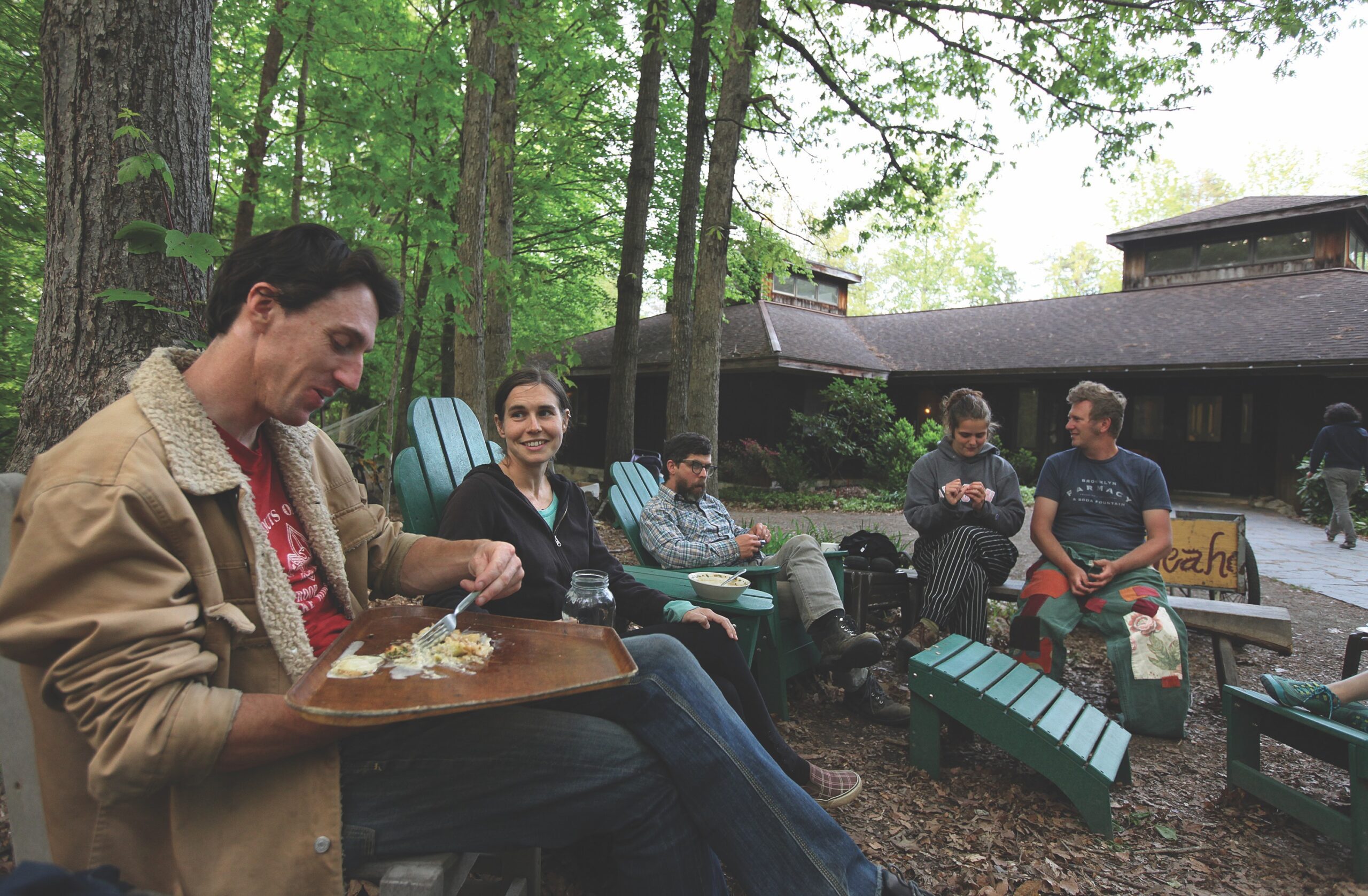There are two things my teenage daughters want to know when I tell them we are going to spend part of March break living on a commune in rural Virginia: Is there Wi-Fi, and how far is the nearest Starbucks? I inform them they’ll have to go a few days without their caramel macchiatos and Keeping Up with the Kardashians. And so, their easy adjustment to the bohemian lifestyle surprises me. Like me, they are intrigued by the folks we meet, people with names like Purl, River and Puck, people who don’t have their own cars, houses or bank accounts and have chosen a life that doesn’t include live television, Twitter or long commutes to work.
Our first morning there, my 16-year-old daughter, Ruby, and I are hoeing in a massive garden under a hot sun, dropping tender pea seeds into tiny holes carved out with our bare hands. Ruby barely bats an eye when another gardener, a voluptuous 40ish redhead, pulls off her shirt in the heat of the midday, her breasts swaying while she tills the soil. My 13-year-old daughter, Lucy, initially bemoans the loss of cellphone reception and then, bored with her own boredom, picks up one of the dozens of rickety bikes on the property and rides down a wooded path to the swimming hole.
You may unsubscribe from any of our newsletters at any time.
On our first night, my husband, the girls and I join a group of people in the lounge to watch the winter Olympics — an entire month after they actually occurred (someone’s mother mailed VHS tapes with 36 hours of coverage). Later, nestled in the visitors’ cabin, the four of us giggle about the huge menstrual chart in one of the common washrooms where the women of the commune track their cycles. We marvel over how delicious dinner was — organic greens, sweet potatoes, rice and beef, fresh bread — most of it grown on the premises. We talk about how much money one really needs to be happy.
Nodding off to sleep that night, I realize we’ve already been profoundly affected by this place known as Twin Oaks.
Located in Louisa County in rural central Virginia, this counterculture colony is one of the largest and oldest secular communes in North America, having been around for almost 50 years. A quirky egalitarian enclave of conscious castaways, it’s situated on a 185-hectare parcel of farmland in the middle of the red Republican heartland. Several Canadians live here, and one of them is Valerie Resnick, 46, who came to Twin Oaks when she was 24 and now serves as a spokesperson for the community. She shows us around the property: the eight residences that house 10 to 20 people each (everyone has their own bedroom), and the large hall that serves as a kitchen, dining room and gathering area. We also see the greenhouses, a dairy, a tofu production facility, a garage for car repairs, a hammock workshop, a free clothing exchange, a hospice and the cemetery where 10 past residents are buried.
Valerie (everyone prefers to use first names here) explains that her decision to live at Twin Oaks is informed by the values she learned growing up in the United Church: being a steward of the Earth, celebrating diversity, striving for social justice, sharing resources and eliminating inequality. She attended City View United in Nepean, Ont., where she was a member of Christian Girls in Training and a United Church camp counsellor. At one point she considered becoming a minister. “The church taught me to live my values, and I’m doing that at Twin Oaks,” she says. “I didn’t want any part of the hamster wheel — the packaged life of the mainstream wasn’t appealing to me. This place fits with my own personal ideology. It’s the closest physical manifestation of the lifestyle I wanted to have.”
Valerie and her fellow “communitarians” reject most of what the “good life” in mainstream culture has to offer: corporate climbing, unlimited consumption, supersized homes, shiny new cars, annual vacations, 24/7 news cycles and the ceaseless striving for money. Here, the good life has an entirely different meaning, one that encompasses self-sufficiency, sharing resources, ecological responsibility, sexual freedom, raising kids as a community, caring for the sick and elderly, working together as a collective and feeling intimately connected.
Before my visit, my idea of commune life was guided by pop culture representations of the slacker hippie lifestyle: barefoot and bare-bottomed children running wild; men with long hair and unruly beards with a penchant for mescaline and mud baths; pretty women with flowers in their hair caressing pan flutes in the middle of the woods; hard-core vegan meals featuring nuts, berries and possibly bark; and a general surfeit of cannabis, carnality and intense campfire discussions about Marxism.
I was kind of right about a few things, but mostly wrong about everything.
For one, this place is no backwater. Progressive practices such as car sharing, green burials and solar energy use have been the norm here for decades. The 100-mile diet popular with North American foodies? Twin Oaks bests that with its 185-hectare diet, growing almost all of its own food. I expected a freewheeling atmosphere, but everyone moves with purpose — on foot, bikes or, for older folks, golf carts — clutching their daily worksheets with their assigned tasks.
Twin Oaks was founded in 1967 by eight people who had the foresight to develop enough bylaws, budgets and systems to make a city planner’s head spin. It’s this structure that has allowed it to survive for decades while thousands of other communes from the 1960s and ’70s flopped. “We are bureaucrats for the revolution,” jokes Valerie. There’s no robed guru or central CEO. Instead, operational responsibility is shared among three key planners who serve 18-month terms, and a host of managers who run the various departments. In exchange for working 42 hours a week in the commune’s business and domestic areas, people here are housed and fed and receive $85 a month in spending money.
A variety of committees look after the human relations side, including a child board, health team and process team for resolving conflicts. Feedback is solicited through the “opinion and idea board,” featuring a couple of dozen clipboards each jammed with stacks of paper several inches thick in which residents offer their views on current issues, such as whether to build another residence or buy another cow. It all runs as efficiently as an ant farm.
While Twin Oaks eschews the personal ambition and corporate greed of capitalism, it recognizes that money is necessary for its survival. Its collective income-sharing businesses — primarily high-end hammock making and soy food production — bring in $1 million a year, which has allowed the commune to expand by adding new members and building additional structures.
Members can pick their own hours and jobs, whether it’s teaching in the preschool, cooking dinner, marketing hammocks at business fairs, working in the office, manufacturing tofu, maintaining the fleet of 15 vehicles, milking cows or doing plumbing and electrical repair work. All work is valued equally. “Whoever is running the million-dollar hammock business earns the same work credits as the person cleaning the bathrooms — and often it’s the same person doing both jobs,” says Valerie.
Most people choose a variety of tasks rather than the same job day in and day out. Every member is mandated to do a single dishwashing shift each week (seems dishwashing is a drag, even in utopia). Members can log longer hours to earn extra days off and work at odd jobs off-site to save money for vacations. The retirement plan allows for a work reduction of one hour per week each year after the age of 50; thus a 70-year-old would be required to work 22 hours a week.
There are advantages to living on the poverty line, namely free health care and dental coverage and subsidized post-secondary education for young people who grow up and leave. You can be technically poor and still live a fairly middle-class lifestyle with access to housing, food, transportation, health care and a bit of pocket money. For a lot of young people who come to live here, that’s a weight off their shoulders. Allie, a 28-year-old Canadian originally from Guelph, Ont., was earning minimum wage working at a food co-op in Pittsburgh before moving to Twin Oaks. “I could barely afford to pay my rent and buy food,” she says. “It’s such a relief for me to know that now all my needs are taken care of.”
In an effort to ensure economic equality among members, no one can build wealth. Most young people come to Twin Oaks with few resources, but some baby boomers have investments that must be parked in trust accounts for the duration of their stay. Seniors hand over their Social Security cheques to the community coffers. When Lori, a 60-year-old pharmacist from Oregon moved to Twin Oaks after retiring about a year ago, she was allowed to rent out her home to keep up the mortgage payments, but she can’t touch her 401(k) retirement savings, and any interest accrued goes to Twin Oaks. She’s got no qualms about that. “I can live here for free, and if it doesn’t work out and I leave, I still have my house and my retirement savings,” she says.
Twin Oaks offers a cushion of social support that’s especially valued by new parents and older folks. Labour credits can be earned for teaching and child minding, so kids develop bonds with a wide variety of adults. Valerie, who has no children of her own, spends a few hours each week with her five-year-old goddaughter, Anya, even putting her to bed one night a week. “This is the perfect place for new parents because there is always someone with lots of fresh energy who is available to supplement parenting,” she says. “And I get a sense of family life without being a biological parent.”
Most kids are home-schooled and have the benefit of learning from folks with a broad range of expertise. For example, 17-year-old Rowan has four tutors, including a former screenwriter from California who is teaching him film studies. His father, Keenan, says the curriculum he envisioned for his son included “learning how to be self-aware, being able to run a meeting effectively, tell 10 good jokes and build a house by the time he was 15.” All of which Rowan has accomplished. Kids are limited to about 15 percent of the population, and according to a policy that Valerie admits “probably seems like the most cult-like thing about us,” couples must seek permission before getting pregnant in order to keep the number of adults and children in balance. (It’s almost always granted.)
At 84, Marione, who grew up in New York state and worked as a social worker before coming here 22 years ago, is Twin Oaks’ oldest resident. She is receiving radiation treatments for cancer, and members of the health team drive her to her appointments at the nearby University of Virginia Hospital in Charlottesville. “I feel very supported here,” says Marione. “All my meals are prepared for me, and there are lots of activities like singing groups that I enjoy. It’s a comfort to be around so many people.”
There are downsides to Twin Oaks. For one thing, it’s messy. The furniture is dingy, and some common areas look like they haven’t seen a broom in months. And there’s not much privacy, except when you’re alone in your room. Nadine, a 53-year-old graphic designer who moved here from Boston two years ago after her marriage ended and she lost her job, eats dinner most nights alone in her room, turning on a fan to drown out any noise. “I’m an introvert,” she says, “so after spending all day with people, I need to be on my own.” Still, she loves the fact that she never has to cook her own meals.
Twin Oaks has its share of interpersonal drama. There are ego clashes and broken hearts. “When you dance so closely together, you can’t help but step on each other’s toes,” says Valerie. There’s a 25 percent turnover every year — the most common reason for leaving is when a relationship ends (the place is too small to avoid a former lover), but many people have been here for decades.
When it comes to personal beliefs and lifestyles, you’ll find folks who span the religions of the world and the LGBT rainbow. There are a smattering of Jews and Quakers, Christians who sing in a local church choir and pagans who dance naked under the full moon during spring solstice. Twin Oaks is home to celibates, singles, serial daters and a handful of monogamous couples. No one bats an eye at open marriages or polyamorous pursuits. “Sexuality is fluid — nobody cares what you are here,” says Valerie, who has been in a monogamous marriage for 18 years.
On our last night, I head over to a bonfire party where a dozen people have gathered to share a bottle of whiskey someone has left as a goodbye gift. The booze loosens my tongue, and I ask the 40ish man beside me about polyamorous relationships at Twin Oaks. He tells me he’s in an open marriage — his wife is bisexual — and they have two kids. I ask how often he takes advantage of the, uh, openness. “Oh, about once or twice a year,” he says, before sharing that he’s currently interested in the redhead who had gone bare-breasted when we were gardening.
Later that night, Sunshine, a young man in his 20s, entertains us by repeatedly leaping over the high fire. He’s delighted when he finds out I’m Canadian. He’d like to live in Canada and says the easiest way to gain residency is by marrying a Canadian. His eyes brighten. “Would you marry me?” he asks in jest. At least, I think it’s in jest.
People’s reactions to Twin Oaks can be surprising. Some come all gung-ho for the three-week trial program fully expecting they’ll become lifers and are never heard from again. By all rights, my husband, Jeff Mahoney, is a closet communist who has always held that the collective good of the community supersedes the needs of the individual. So he should embrace Twin Oaks.
Instead, he hangs back, finds the people unfriendly and gets peeved when a woman knocks on our bedroom door one night when he’s playing guitar to tell him that it’s quiet time after 10 p.m. “Too many rules,” he mutters. After a rough night’s sleep on the thin mattress of our bunk bed, he wakes up with a sore back. His mood isn’t much better. I suggest that he misses certain creature comforts, specifically the six-inch down-filled mattress pad on our bed back home. “Capitalism is looking better and better all the time,” he quips.
I can’t decide if the people at Twin Oaks are more eccentric or more enlightened — perhaps a bit of both — but they’ve shown me an alternative model of right living, one where someone like Jesus might feel right at home, long hair and all. “In many ways we are a seamless extension of the United Church’s call for living in a more economically and socially just relationship to the rest of the world around us, and being responsible stewards of Creation,” says Valerie.
I find myself thinking about Twin Oaks long after I return home. In my daydreams, I’m borne back to its primal rhythms of work and co-operation, curious about its fluidity of relationships and envious of its community and closeness to nature.
I buy a hammock for the backyard. It’s a start.
***
This story first appeared in The United Church Observer’s June 2014 issue with the title “The Communitarians.”














